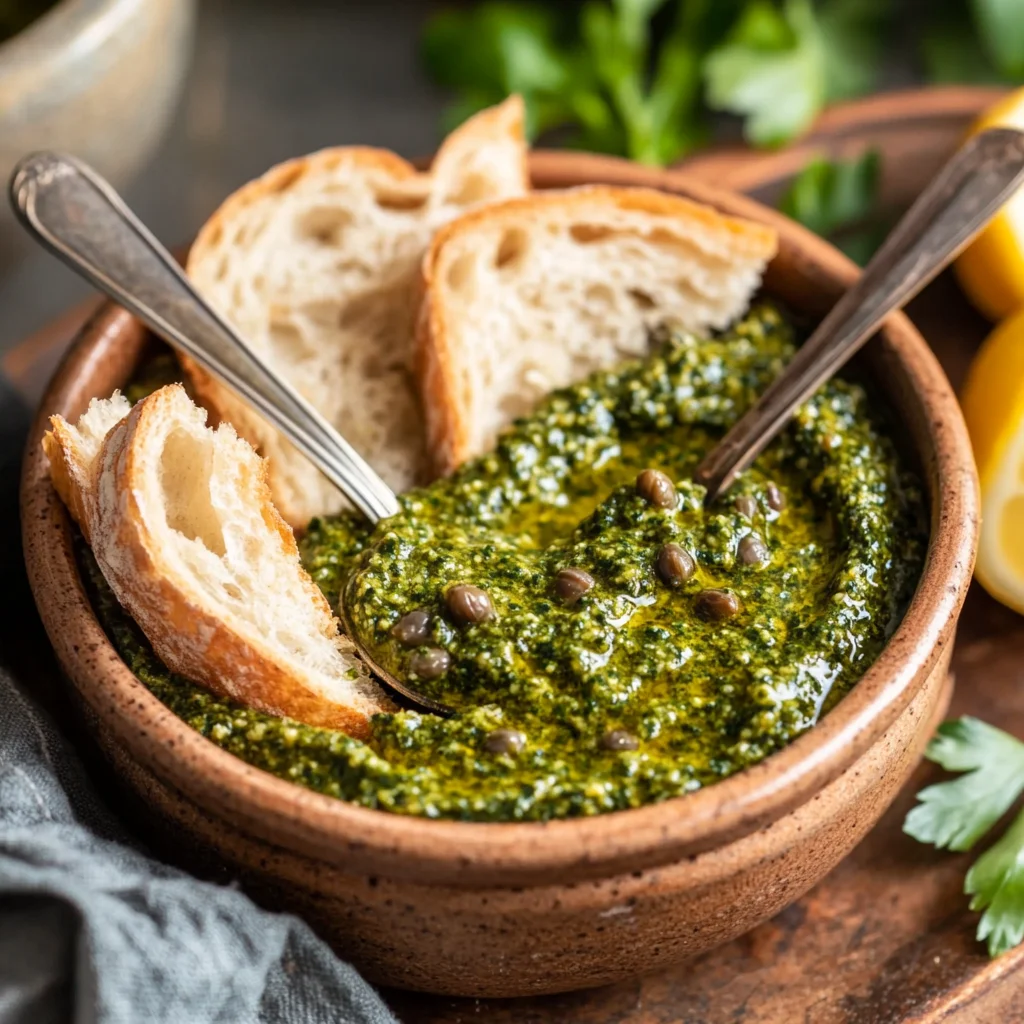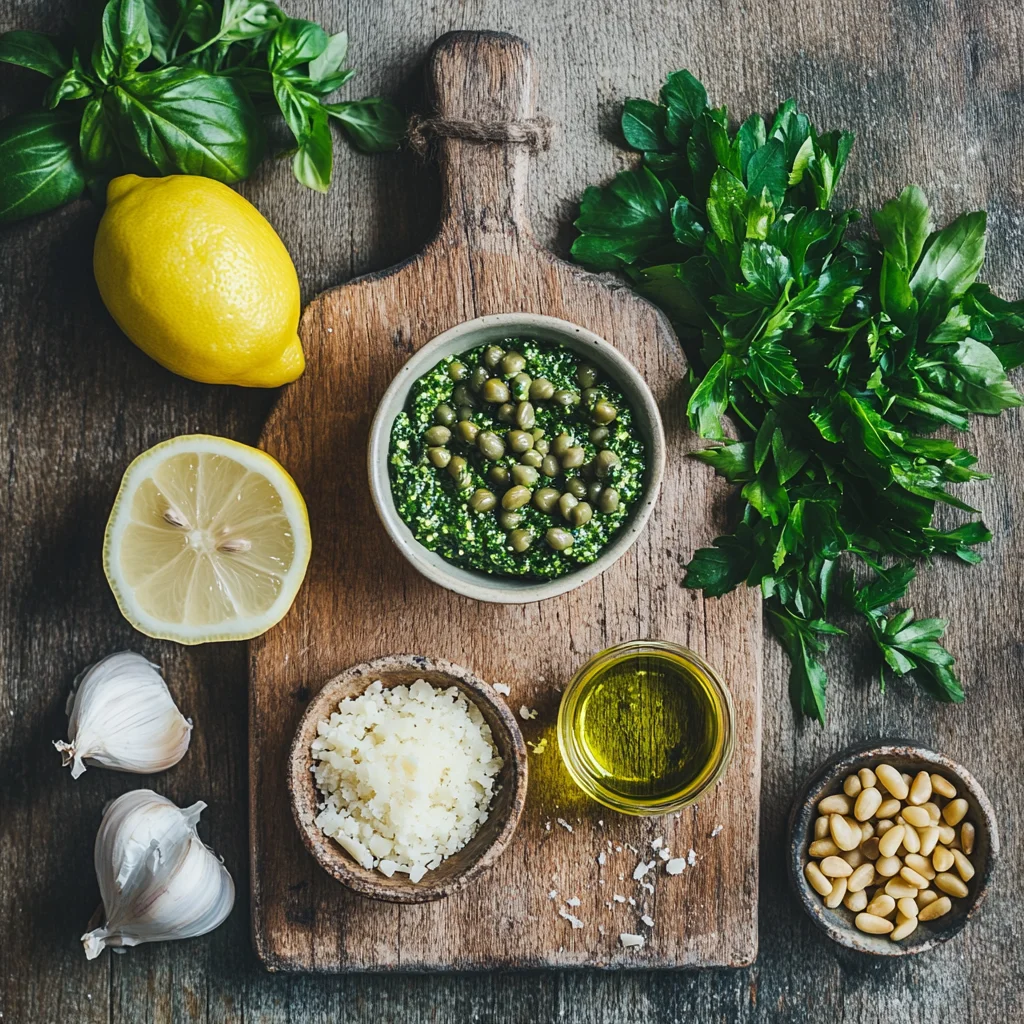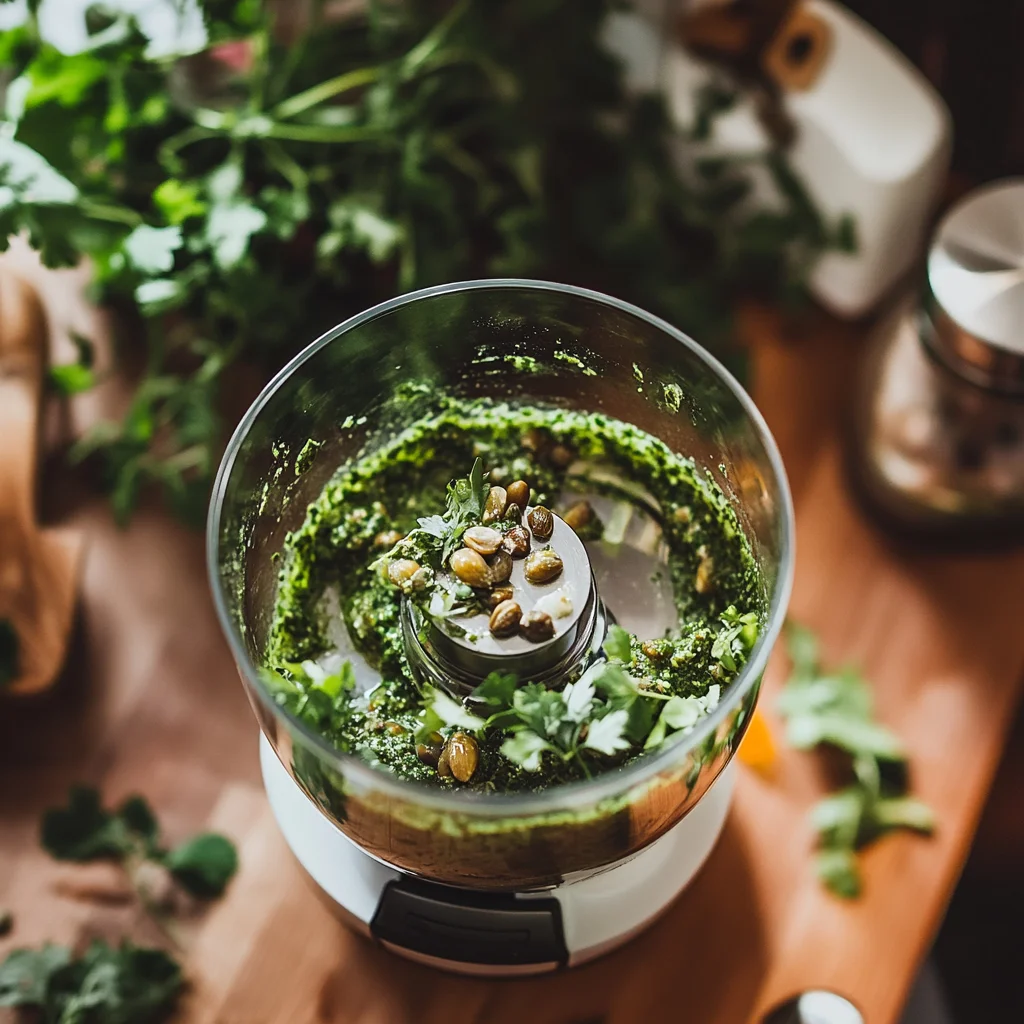
Introduction
Caper pesto is a flavorful variation of the traditional pesto, offering a tangy, zesty twist to elevate your meals. Whether you’re a pesto enthusiast or looking for new ways to add flavor to your dishes, caper pesto offers a unique combination of capers, garlic, olive oil, and herbs that will tantalize your taste buds. In this article, we’ll dive deep into the history, ingredients, preparation steps, and creative ways to use caper pesto.
Table of Contents
Part 1: What is Caper Pesto?
Caper pesto is a twist on the classic Italian pesto. Unlike traditional pesto, which uses pine nuts, caper pesto swaps these nuts for capers. The result is a tangy, salty sauce that’s packed with Mediterranean flavors. It’s simple, fresh, and versatile, making it perfect for a variety of dishes.
The Origins of Caper Pesto
Pesto originated in Genoa, Italy, and is traditionally made with basil, garlic, pine nuts, Parmesan cheese, and olive oil. Over time, chefs and home cooks began experimenting with different ingredients. Caper pesto is one such variation, incorporating capers for their salty, briny flavor. The addition of capers gives this pesto a unique character while still maintaining the creamy, herbaceous base of the original.
Key Ingredients of Caper Pesto
The essential ingredients of caper pesto include capers, garlic, olive oil, herbs, and Parmesan cheese. These ingredients create a balance of flavors: the briny capers offer a sharp contrast to the smooth olive oil and savory Parmesan. Fresh herbs, such as basil or parsley, bring freshness, while garlic adds a pungent depth.
Part 2: Health Benefits of Caper Pesto
Caper pesto not only adds amazing flavor to your meals but also offers numerous health benefits. By incorporating this unique pesto into your diet, you can enjoy both the taste and nutritional value it brings to the table. Let’s explore the key health benefits of caper pesto and why it’s a great choice for those looking to improve their well-being.
Rich in Antioxidants
Capers are packed with antioxidants, which help fight free radicals in the body. This can reduce oxidative stress and inflammation, potentially lowering the risk of chronic diseases. When combined with other ingredients like olive oil and fresh herbs, caper pesto becomes a powerful source of antioxidants that support overall health.
Good for Heart Health
The main ingredient in caper pesto—olive oil—is known for its heart-healthy properties. It contains monounsaturated fats, which are linked to a reduced risk of heart disease. In addition, capers themselves are a good source of vitamin K, which plays an essential role in regulating blood clotting and supporting heart health.
Aids in Digestion
Capers are also rich in fiber, which is essential for a healthy digestive system. Fiber aids in digestion, prevents constipation, and helps maintain a healthy gut. Regular consumption of fiber-rich foods like caper pesto can support proper digestion and overall gut health.
Supports Bone Health
Capers provide a good amount of calcium, an essential mineral for strong bones and teeth. When combined with other ingredients like Parmesan cheese, which also contains calcium, caper pesto can be a helpful addition to your diet if you want to support bone health.
Part 3: How to Make Caper Pesto
Now that we’ve covered the health benefits of caper pesto, let’s dive into the step-by-step process of making this flavorful sauce at home. The good news? It’s easy, quick, and requires only a handful of ingredients.
Ingredients
To make your own caper pesto, gather the following ingredients:
- 1/4 cup of capers, drained and rinsed
- 2 cloves of garlic, peeled
- 1/4 cup of extra virgin olive oil
- 1 tablespoon of lemon juice
- 1/4 cup of grated Parmesan cheese (optional for a vegan version, you can skip it or use a plant-based alternative)
- 1/4 cup of fresh herbs (basil, parsley, or a mix of both)
- Salt and pepper to taste

Step-by-Step Instructions
- Prepare the Ingredients
Start by draining and rinsing the capers to remove excess brine, which can make the pesto too salty. Peel and chop the garlic cloves. If you’re using Parmesan, grate it now. - Blend the Pesto
In a food processor, add the capers, garlic, olive oil, lemon juice, and fresh herbs. Pulse the ingredients until they form a smooth paste. For a chunkier texture, pulse a few times rather than blending continuously. - Add the Cheese
If you’re including Parmesan cheese, add it to the food processor now and pulse until combined. This step will make your pesto creamier and richer. - Taste and Adjust
Taste the pesto and adjust the seasoning with salt and pepper. If the pesto is too thick, add a little more olive oil or lemon juice to achieve your desired consistency. - Serve or Store
You can use the caper pesto immediately, or transfer it to an airtight container and store it in the fridge for up to a week.

Part 4: Creative Ways to Use Caper Pesto
Now that you’ve made your caper pesto, it’s time to get creative and incorporate it into a variety of dishes! This vibrant, tangy pesto pairs wonderfully with many foods, from pasta to grilled vegetables, meats, and even as a sandwich spread. Let’s explore a few ways to elevate your meals with this delicious condiment.
1. Tossed with Pasta
One of the easiest and most popular ways to enjoy caper pesto is by tossing it with pasta. Whether you choose spaghetti, penne, or your favorite type of pasta, this pesto adds a flavorful punch. Just cook your pasta as usual, and then toss it in a generous amount of caper pesto. For an extra touch, sprinkle some freshly grated Parmesan and add a few extra capers for garnish.
2. Spread on Sandwiches and Wraps
Looking to add a zesty twist to your sandwiches or wraps? Caper pesto makes an excellent spread. Use it in place of mayonnaise or mustard for a tangy, Mediterranean-inspired filling. It pairs perfectly with grilled chicken, roasted vegetables, or even a simple veggie sandwich. For wraps, try spreading the pesto on the tortilla before adding your filling for an extra burst of flavor.
3. Drizzle Over Grilled Vegetables
Grilled vegetables are a fantastic complement to caper pesto. Whether you’re grilling zucchini, bell peppers, or eggplant, drizzle a spoonful of pesto over the top for a fresh and vibrant finish. The rich, savory taste of the pesto enhances the smokiness of the grilled veggies, making them even more delicious.
4. As a Dip for Bread or Crackers
Caper pesto also works as a dip for crusty bread, crackers, or even vegetables. Simply serve it in a small bowl alongside your favorite dipping snacks. This is a great appetizer or side dish for gatherings or meals when you need something quick yet impressive.
5. Topping for Grilled Meats or Fish
For a Mediterranean flair, spoon a little caper pesto over grilled meats such as chicken or lamb. It also pairs wonderfully with grilled fish, especially white fish or salmon. The pesto complements the richness of the meat or fish while adding that tangy, briny kick from the capers.
6. In Salads
Use caper pesto as a salad dressing for a tangy, herbaceous finish. It’s great with mixed greens, arugula, or even a Mediterranean-inspired salad with olives, tomatoes, and cucumbers. You can also mix it with quinoa, couscous, or farro for a light, flavorful salad.
Part 5: Storing and Preserving Caper Pesto
After making your caper pesto, you might be wondering how to store it to keep it fresh for longer. Luckily, pesto is easy to store and can last for a few days in the fridge or even be frozen for later use.
Storing in the Refrigerator
Store your caper pesto in an airtight container in the refrigerator. Be sure to cover the surface of the pesto with a thin layer of olive oil to prevent oxidation and maintain its vibrant green color. This should keep the pesto fresh for up to a week. Just give it a good stir before using.
Freezing Caper Pesto
If you want to store your pesto for a longer period, freezing is a great option. Simply spoon the pesto into an ice cube tray and freeze. Once frozen, transfer the pesto cubes to a freezer-safe bag or container. This way, you can take out a portion of pesto whenever you need it, making meal prep even easier.
Part 6: Variations of Caper Pesto
While the classic caper pesto recipe is delightful on its own, there are several fun variations you can try depending on your taste preferences or dietary needs.
1. Vegan Caper Pesto
To make a vegan version of caper pesto, simply omit the Parmesan cheese and either skip it altogether or substitute with a vegan cheese alternative. Nutritional yeast is also a great addition to give a cheesy, savory flavor without using dairy.
2. Nut-Free Caper Pesto
For those with nut allergies or anyone avoiding nuts, you can easily make a nut-free caper pesto by simply leaving out any nuts or seeds. The capers already provide enough salty depth, so you won’t miss the crunch. Just focus on the garlic, olive oil, and herbs for flavor.
3. Spicy Caper Pesto
If you like a bit of heat, add a few red pepper flakes to your caper pesto recipe. The spicy kick will balance beautifully with the tanginess of the capers, creating a vibrant, bold pesto. You can also try adding fresh chili peppers for an extra fiery punch.
4. Lemon Caper Pesto
For an extra citrusy kick, increase the amount of lemon juice or zest in your pesto. The acidity of the lemon brightens the pesto and makes it even more refreshing, making it perfect for spring or summer dishes.
Part 7: Tips and Tricks for Perfecting Your Caper Pesto recipe
While making caper pesto is relatively simple, there are some tips and tricks that can elevate the flavor and texture to the next level. Whether you’re a first-timer or a pesto pro, these helpful pointers will ensure that your pesto turns out perfect every time.
1. Use High-Quality Olive Oil
The olive oil you choose can make or break your caper pesto. Opt for extra virgin olive oil, as it provides a rich, fruity flavor that complements the capers and herbs. The quality of olive oil directly affects the overall taste of the pesto, so don’t skimp on this ingredient.
2. Adjust the Texture
If you prefer a smoother pesto, blend it longer in the food processor until you achieve a silky consistency. For a chunkier texture, pulse it a few times rather than blending continuously. You can also adjust the amount of olive oil to make the pesto thicker or thinner, depending on your preference.
3. Balance the Saltiness
Capers can be quite salty, so it’s important to balance the flavor. If your caper pesto turns out too salty, try rinsing the capers more thoroughly before use. Alternatively, you can reduce the amount of capers in the recipe and add a little more lemon juice or herbs to help balance the flavors.
4. Add a Touch of Lemon Zest
For a more aromatic, citrusy note, try adding lemon zest to your caper pesto. This will enhance the bright, fresh flavors without overpowering the tangy capers. It’s a great way to take your pesto to the next level.
5. Experiment with Different Herbs
While basil and parsley are classic choices, feel free to experiment with other fresh herbs to create a unique version of caper pesto. Try tarragon for a slightly licorice flavor or mint for a refreshing twist. The possibilities are endless, and mixing herbs allows you to personalize the pesto to your taste.
6. Toast the Garlic (Optional)
Raw garlic adds a bold, pungent flavor to pesto, but if you prefer a milder taste, consider toasting the garlic in a pan before blending it. Toasting it will soften the sharpness and bring out a more delicate, nutty flavor, which works particularly well if you’re using a nut-free variation of caper pesto.
Part 8: Pairing Caper Pesto with Wine and Other Beverages
Although caper pesto pairs wonderfully with many dishes, knowing which beverages complement the flavors can take your meal to a whole new level. Let’s take a look at some great pairing options.
Wine Pairings for Caper Pesto
While we’ve avoided mentioning alcoholic beverages in the article so far, it’s worth noting that caper pesto can go wonderfully with certain wines. A crisp, dry white wine like Sauvignon Blanc or Pinot Grigio complements the herbal and tangy flavors of the pesto. If you prefer red wine, a light red like Pinot Noir works well without overpowering the flavors.
Non-Alcoholic Pairings
If you’re looking for a non-alcoholic option, a refreshing sparkling water with a slice of lemon or cucumber makes a perfect accompaniment to caper pesto. The fizz cleanses your palate between bites, while the citrus enhances the bright flavors of the pesto.
Conclusion
Caper pesto is a delightful variation of traditional pesto that combines the salty brininess of capers with the freshness of herbs and the richness of olive oil. Whether you use it as a sauce for pasta, a spread for sandwiches, or a topping for grilled vegetables, the possibilities are endless. This simple yet flavorful condiment offers numerous health benefits and can be stored and used in many ways.
From the basic recipe to creative variations and storage tips, we’ve covered everything you need to know to master caper pesto. So, grab your ingredients, get blending, and enjoy this Mediterranean-inspired treat! Whether you’re an experienced cook or just starting out, caper pesto is sure to become a favorite in your kitchen.
Part 9: Frequently Asked Questions (FAQs) About Caper Pesto
As you dive deeper into the world of caper pesto, you may have some questions about how to make, store, or use this flavorful sauce. Don’t worry—we’ve gathered the most common questions and answered them to make sure you get the most out of your pesto experience.
1. How long does caper pesto last in the fridge?
Caper pesto will last up to one week in the refrigerator when stored properly in an airtight container. To maintain its vibrant color and freshness, cover the surface of the pesto with a thin layer of olive oil before sealing the container. This will help prevent oxidation and preserve its flavor.
2. Can I freeze caper pesto?
Yes, you can freeze caper pesto for long-term storage. Simply spoon the pesto into an ice cube tray and freeze. Once the pesto is frozen, transfer the cubes into a freezer-safe bag or container. This way, you can easily thaw individual portions whenever you need them. Frozen pesto will last for up to three months.
3. What can I use caper pesto with?
Caper pesto is incredibly versatile! You can use it with pasta, sandwiches, wraps, grilled vegetables, meats, fish, and salads. It’s also a great dip for bread and crackers. Experiment with different dishes to find your favorite way to use this tangy sauce.
4. Is caper pesto vegan?
Traditional caper pesto is not vegan due to the inclusion of Parmesan cheese. However, you can easily make a vegan version by omitting the cheese or substituting it with a plant-based alternative, such as nutritional yeast or vegan Parmesan.
5. Can I substitute capers with something else?
While capers are the main ingredient in caper pesto, you can experiment with substitutes if you don’t have them on hand. Green olives or pickles can offer a similar briny, salty flavor, though they may change the overall taste of the pesto. However, capers provide a distinct taste that’s hard to replicate, so it’s best to use them for the most authentic pesto flavor.
6. What herbs can I use in caper pesto?
While basil and parsley are the most commonly used herbs in caper pesto, you can get creative with other fresh herbs. Consider using cilantro for a fresh, citrusy twist or thyme for an earthier flavor. You can even combine multiple herbs to create your own signature pesto.
7. How do I make caper pesto less salty?
If you find the caper pesto too salty, rinse the capers thoroughly before using them. You can also adjust the amount of capers you add to the pesto or reduce the amount of salt during preparation. If the pesto is still too salty, balance the flavor by adding more olive oil, herbs, or a squeeze of lemon juice.
8. Can I make caper pesto without a food processor?
Yes, you can make caper pesto without a food processor! If you don’t have one, use a mortar and pestle to grind the ingredients into a paste. You can also chop the capers, garlic, and herbs finely and mix them by hand with the olive oil and lemon juice. It will take a little longer, but the result will be just as delicious!

8 thoughts on “Caper Pesto: A Flavorful Twist on Classic Pesto”